Recent Articles
Popular Makes
Body Types
2014 Mitsubishi Outlander Crossover SUV Road Test and Review
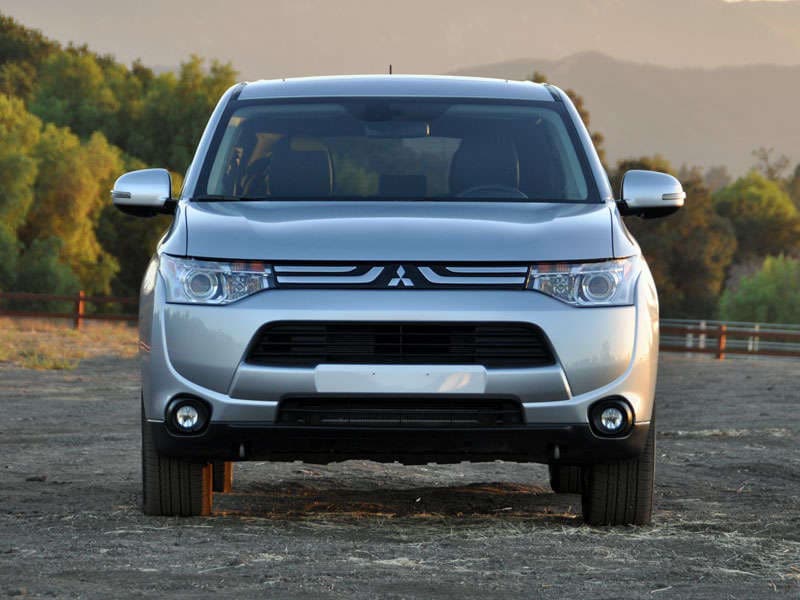
Here it is, Mitsubishi’s moon shot. That might sound overly dramatic, but if the redesigned 2014 Outlander doesn’t make a dent in the compact crossover SUV segment, where it competes against at least a dozen established players from America, Asia, and Europe, it is not beyond comprehension that after three star-crossed decades in the U.S. market, Mitsubishi could call it quits and pull up stakes just like Suzuki did last year.
Therefore, the new 2014 Outlander has a big job to do. First, it needs to establish Mitsubishi as the builder of something other than the legendary Lancer Evolution and the strange egg-shaped electric car with the name nobody can remember. Second, it is the platform that the automaker is using to introduce its new plug-in hybrid powertrain, a lifeline to whatever Mitsubishi’s future might be. Third, it needs to give compact crossover SUV buyers a really good reason to take a pass on the competition, especially considering Mitsubishi’s shrunken dealer network.
Right now, things are looking good for the Outlander, and not just because it comes with a terrific warranty. This SUV is affordable, it puts up impressive EPA fuel economy numbers, it gets a fantastic crash-test rating, and except for the redesigned 2014 Nissan Rogue, it’s the only model in its class that offers a third-row seat. Plus, that plug-in hybrid version is right around the corner, a compact crossover SUV exclusive, just like its available V-6 engine.
To find out if the new Outlander is as good in person as it is on paper, I borrowed one for a week, and Mitsubishi sent over a loaded GT model with a V-6 engine, Super All-Wheel Control (AWC), and a window sticker reading an improbable $34,720.
2014 Mitsubishi Outlander Crossover SUV Road Test and Review: Models and Prices
Mitsubishi sells the new 2014 Outlander in ES ($23,820 – including the $825 destination charge), SE ($24,620), and GT ($28,620) trim levels. The Outlander ES is offered only with a 4-cylinder engine and front-wheel drive. The Outlander GT is available only with a V-6 engine and Super All-Wheel Control (S-AWC) all-wheel drive. In between, the Outlander SE is available with a 4-cylinder engine and a choice between front-wheel drive or S-AWC.
Because the Outlander SE costs just $800 more than the Outlander ES, and includes far more than that amount of money in added value, its my pick for the best of the bunch. In addition to ES equipment, the SE gets Bluetooth, attractive 18-inch aluminum wheels, fog lights, nicer interior trim, and heated front seats. Dual-zone automatic climate control is also included for this model, as well as Fast Key passive entry with push-button starting, a 6.1-inch touchscreen infotainment system, a USB port, and a reversing camera.
While this represents good value, keep in mind that the S-AWC system adds another two grand to the window sticker, so you’d really better be incapable of driving in the snow in order to justify the extra expense.
My test vehicle is the Outlander GT, which includes the S-AWC system and a V-6 engine, plus a 6-speed Sportronic automatic transmission with paddle shifters, and HID headlights providing what Mitsubishi calls a “super wide beam.”
Options for all Outlander models include a Navigation Package, an Entertainment Package, rear parking assist sensors, towing equipment, cargo solutions, remote engine starting, LED cabin lighting, roof rack crossbars, and more. Additionally, the ES can be fitted with Bluetooth and fog lights, while the Outlander SE and GT are available with a Premium Package (leather seats, power driver’s seat, power sunroof, premium sound system, power tailgate) and a Touring Package (Premium Package plus automatic headlights, rain-sensing wipers, navigation system, Adaptive Cruise Control, Lane Departure Warning, Forward Collision Mitigation System).
My Outlander GT had the Touring Package, explaining how its price tag ballooned to nearly $35,000.
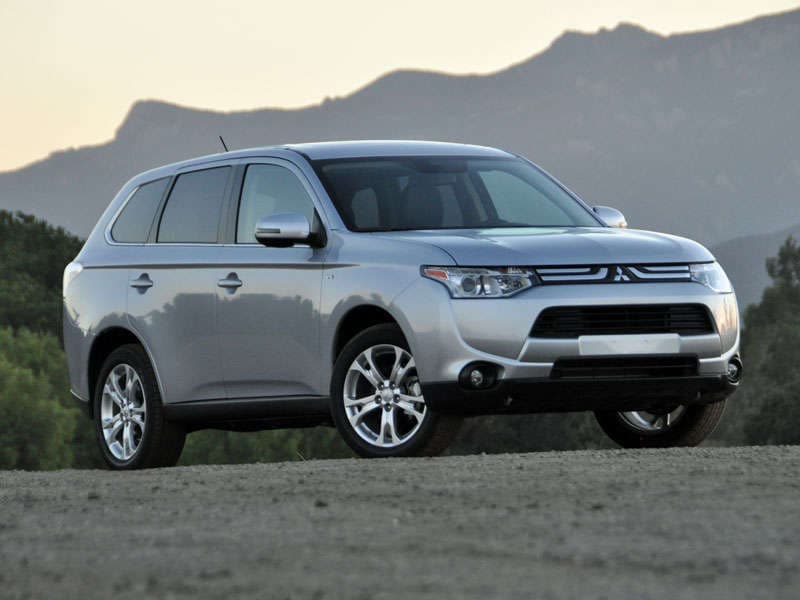
2014 Mitsubishi Outlander Crossover SUV Road Test and Review: Design
- Reduced aerodynamic drag
- Lighter by 200 pounds
- Improved interior materials
Do you like the way the new Outlander looks? This is supposed to be the direction Mitsubishi is taking with future models, though the new 2014 Mirage mini-car doesn’t have the Outlander’s scowling front end, new grille panel design, or the character lines sweeping down from the headlights into the lower air intake.
From the front wheels back, the Outlander is fairly conventional and conservative in appearance, which isn’t a bad thing. Clear lens taillights add a little bit of character, and I really like the 18-inch aluminum wheels that are standard on the SE and GT models.
In photos, the Outlander’s cabin looks plain and dated, but in reality Mitsubishi does a lot of things right with this SUV’s interior, and it looks convincingly upscale with the optional leather upholstery. Still, the headliner looks and feels cheap in contrast to pleasing tones and textures elsewhere, and the fake wood that comes standard in the GT model really ought to be replaced by fake aluminum.
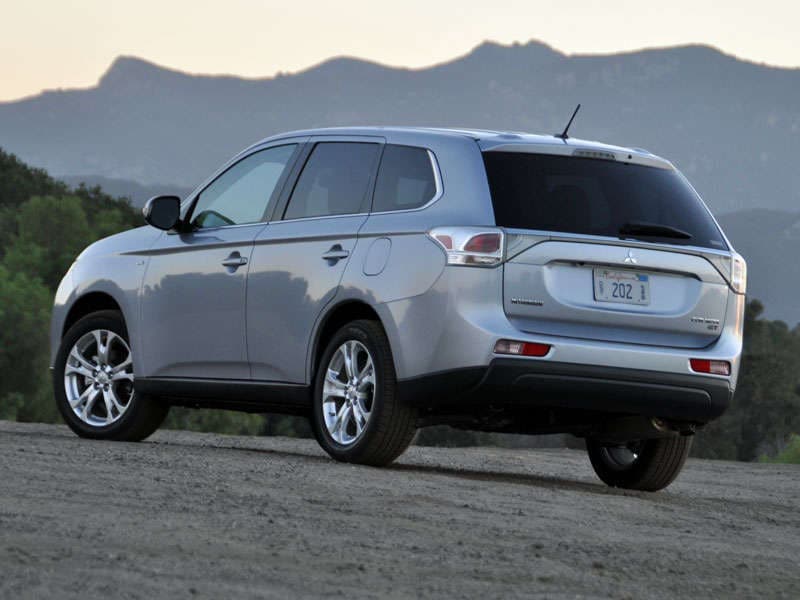
2014 Mitsubishi Outlander Crossover SUV Road Test and Review: Comfort and Cargo
- Additional sound insulation for quieter cabin
- Seats easier to fold for maximum cargo space
Comfort isn’t a problem when it comes to the 2014 Outlander, unless you’re crammed into the third-row seat. Then everyone except for the driver and front passenger gets grumpy.
My Outlander GT’s front seats were reasonably comfortable and supportive, and the fat-rimmed tilt/telescopic steering wheel proved pleasing to grip. Thankfully, Mitsubishi softly pads the areas where the driver is likely to rest his or her elbows. Still, I’d like another inch or two of rearward travel for the driver’s seat, and taller people might reject the Outlander for cramping their legs.
The Outlander’s second-row seat is more comfortable than its front seats. When they’re moved all the way back in their track, there’s plenty of legroom and a massive amount of foot room. Plus, the cushions sit up nice and high, and the backrests recline for greater comfort.
The third-row seat is torturous for adults. Even if the second-row is moved forward so that passengers’ legs are flush against the soft front seat backs, there isn’t enough space in the third-row seat for grown-ups. Therefore, this area is for kids only, and if you’ve got a couple of child safety seats installed in the second-row seat, good luck loading anyone into it.
Unfortunately that occasional-use, kids-only, third-row seat chews up space that could be used for cargo. When it is folded down – as it likely will be the majority of the time – the Outlander provides a competitive 34.2 cu.-ft. of cargo space, about the same as the Ford Escape but a little less than the Honda CR-V and Toyota RAV4. Imagine what that number could be if Mitsubishi jettisoned the third-row seat.
When the third-row seat is raised, it leaves a scant 10.3 cu.-ft. of cargo space in a narrow space between the seat and the tailgate, which means that you can carry extra people or extra cargo, but not both. Fold both rows of seats down, and maximum cargo space measures 63.3 cu.-ft., significantly less than the segment leaders.
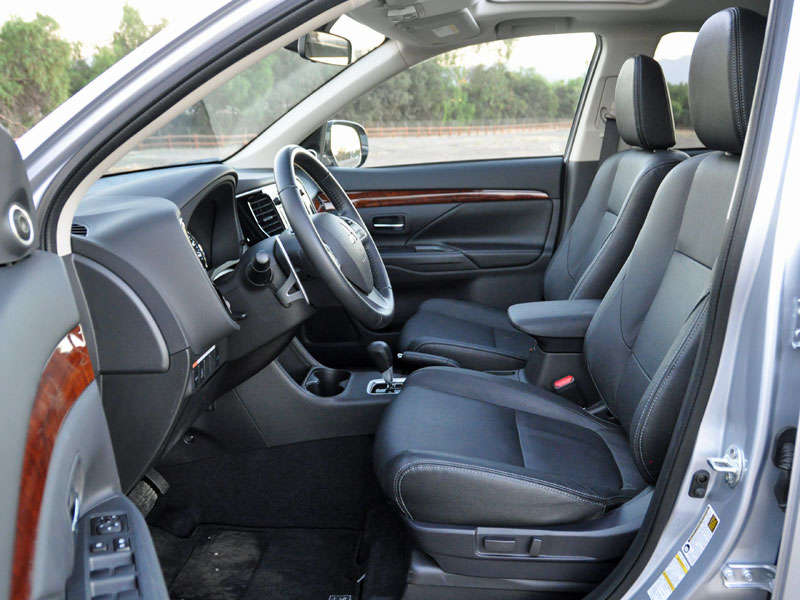
2014 Mitsubishi Outlander Crossover SUV Road Test and Review: Features and Controls
- Added standard equipment
- Optional next-generation navigation system
- New safety technology options
It doesn’t take long to figure out how the new Outlander works. The controls look, feel, and operate with greater refinement and practicality than might be expected, and for the most part this SUV is logically laid out, but there are some faults and quirks.
For example, the navigation system looks and operates like an aftermarket unit, working at a seemingly glacial pace and occasionally suffering what might best be described as wiring schizophrenia. Additionally, though I drove a well-equipped version of the Outlander, the interior was littered with “blanks,” the fake buttons that fill the spaces where missing equipment might otherwise be located. Also note that the stability control system’s “off” button is located right next to the trip computer button, which seems a little bit dangerous to me.
One cool aspect of the Outlander GT is that it gets paddle shifters that are mounted to the steering column rather than the steering wheel, making them perfect for enthusiast drivers who like to shuffle steer. Yeah, like that’s gonna happen in an Outlander.
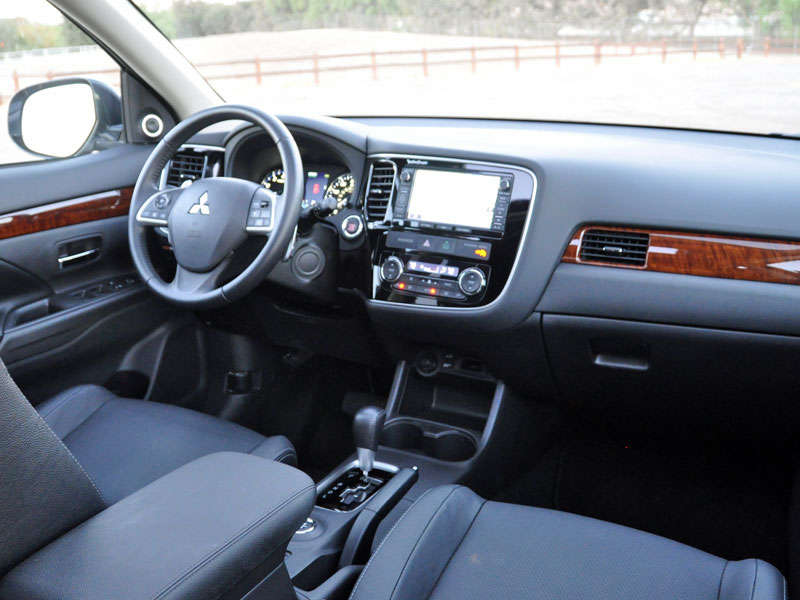
2014 Mitsubishi Outlander Crossover SUV Road Test and Review: Safety and Ratings
- Optional Lane Departure Warning system
- Optional Adaptive Cruise Control system
- Optional Forward Collision Mitigation system
In addition to a driver’s knee airbag, the new Outlander is available with a Lane Departure Warning system and an Adaptive Cruise Control system with Forward Collision Mitigation technology. The latter feature can be calibrated for different driving situations, like stopping and going and traffic as compared to driving on the freeway. These are useful features, but are only available in the expensive Touring Package option for the SE and GT models.
Though the National Highway Traffic Safety Administration (NHTSA) has not performed crash tests on the new Outlander, the Insurance Institute for Highway Safety (IIHS) has subjected the SUV to its rounds of testing, and the result is a “Top Safety Pick Plus” rating.
As this review is written, that makes the Outlander one of three compact SUVs to achieve that rating, and it also means that this Mitsubishi is perfect for serving family shuttle duties.

2014 Mitsubishi Outlander Crossover SUV Road Test and Review: Engines and Fuel Economy
- Improved powertrains
- Driver-activated Eco driving mode
- New electric steering system
- New, lighter version of Super All-Wheel Control AWD
- Super All-Wheel Control offered with 4-cylinder engine
- Plug-in Hybrid version arriving in 2014
The Outlander ES and SE have a standard 2.4-liter 4-cylinder making 166 horsepower at 6,000 rpm and 162 lb.-ft. of torque at 4,200 rpm, and a continuously variable transmission (CVT) feeds this power to the front wheels. The SE model is available with Mitsubishi’s Super All-Wheel Control (S-AWC) all-wheel-drive system, which offers Eco, Normal, Snow, and Lock driving modes.
The Outlander GT is equipped with standard S-AWC and a 3.0-liter V-6 making 224 horsepower at 6,250 rpm and 215 lb.-ft. torque at 3,750 rpm while burning premium unleaded fuel. The V-6 bumps towing capacity from 1,500 lbs. to 3,500 lbs.
As might be expected, the 4-cylinder engine is rated to return the best fuel economy, with the EPA saying it will get 27 mpg in combined driving with front-wheel drive, and 26 mpg with S-AWC. The Outlander GT’s V-6 returns 23 mpg in combined driving, and based on my testing, that’s an optimistic figure. I got 19.5 mpg, and used the Eco driving mode for at least half of the miles covered.
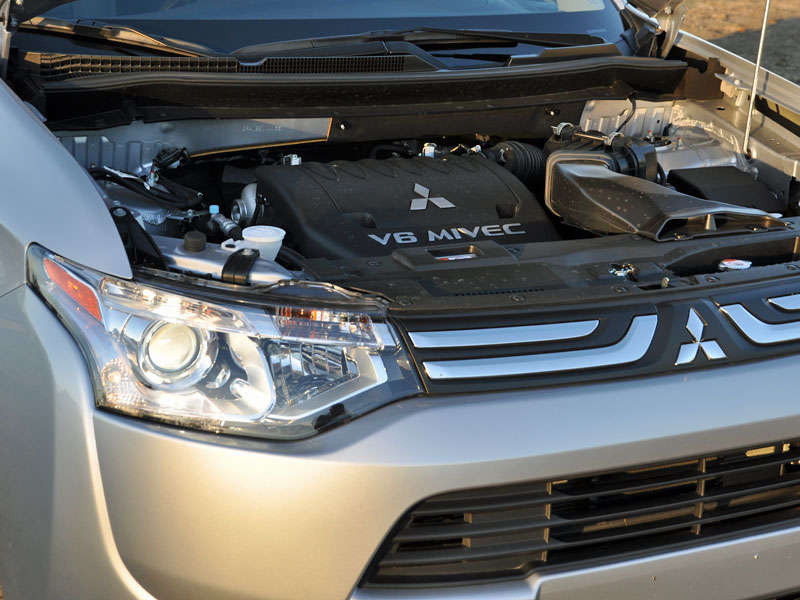
2014 Mitsubishi Outlander Crossover SUV Road Test and Review: Driving Impressions
Around town, the Outlander’s refined suspension tuning, impressive roll control, surprisingly communicative steering, and easily modulated brakes make the Outlander feel more nimble than many compact crossovers. But there’s no getting around it. The Outlander GT’s V-6 lacks gusto unless you turn off the Eco Mode and rev it up. In that scenario, this SUV accelerates with satisfying strength, and convinces that it can tow 3,500 lbs. Trouble is, when you drive like that, fuel economy takes a crippling nose dive, and this V-6 requires premium fuel.
Ouch.
As a result, you’re likely to keep the Outlander GT’s Eco Mode engaged. That means the transmission upshifts early. The air conditioning doesn’t blow as strong or as cold. And the Outlander is an utter bore to drive, feeling sluggish and lethargic as the powertrain attempts to deliver the best fuel economy.
That’s why most people will probably want to reserve the Eco Mode for highway driving, where in my experience the Outlander can put up numbers that close in on 25 mpg. However, on the highway, the Outlander’s suspension allows some pitch, rock, and roll at the same time that it clearly communicates sharper impacts and pavement textures. Combine these traits with straight-line steering quality that feels light and loose right on center as well as heavy and wooden right off center, and the Outlander doesn’t feel like something you want to drive very fast or very far on the freeway.
Take the Outlander GT on a twisty mountain road, and it’s easy to spot hints of the Lancer Ralliart and Evolution in this crossover SUV. The steering, suspension, and brakes combine to deliver a more entertaining performance than most crossovers, and the GT model’s long, slender, fixed-position paddle shifters are terrific, too. Too bad they issue commands to a lackluster powertrain, which means the Outlander is better when going downhill than when going uphill.
All that’s really missing from the Outlander GT’s recipe is a decent turbocharged 4-cylinder engine, or a stronger V-6, maybe one that doesn’t gorge itself on premium gas when the driver uses the motor for its intended purpose.
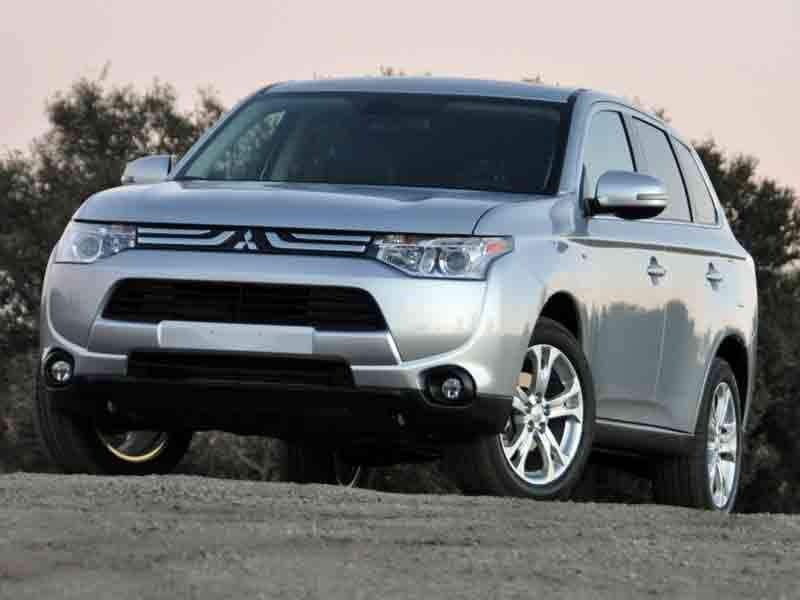
2014 Mitsubishi Outlander Crossover SUV Road Test and Review: Final Thoughts
While imperfect, the 2014 Mitsubishi Outlander has several things going for it. It is very safe, boasting a Top Safety Pick Plus crash-test rating. It offers a long and comprehensive warranty. It delivers impressive value if you can resist checking option boxes. It offers the only V-6 engine option in its class, and soon will offer the only plug-in hybrid option. Some people might even find the third-row seat to be a benefit.
Unfortunately, it seems as though there is a negative for every positive. The optional V-6 engine is thirsty and requires premium unleaded. The price tag rises to alarming heights when helping yourself to the options menu. Mitsubishi’s dealer network is downright skeletal, making it hard to get service and warranty work performed. The Outlander’s third-row seat results in less cargo volume than key competitors.
So what’s the verdict? Let’s call the new Outlander a big step for Mitsubishi in the right direction, and acknowledge that it remains a work in progress.
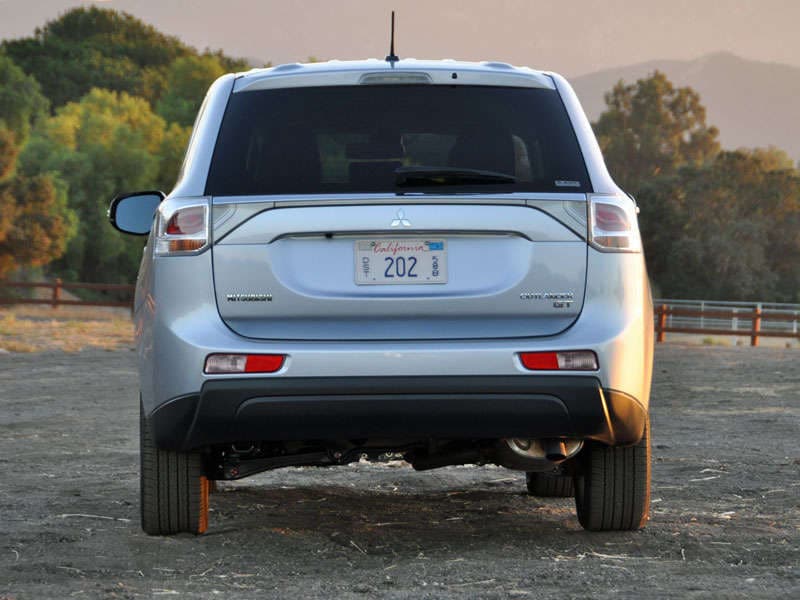
2014 Mitsubishi Outlander Crossover SUV Road Test and Review: Pros and Cons
- “Top Safety Pick Plus” crash-test rating
- Long warranty and roadside assistance plans
- Entertaining to drive when thrashed
- Comfortable front and second-row seats
- Useful safety technologies
- Plug-in hybrid model soon to debut
- Needs more accessible power
- V-6 engine’s thirst for premium
- Unsettled highway ride
- Compromised cargo space
- Third-row seat unfit for adults
- Adding options makes for poor value
Mitsubishi supplied the vehicle for this review
2014 Mitsubishi Outlander photos by Christian Wardlaw
